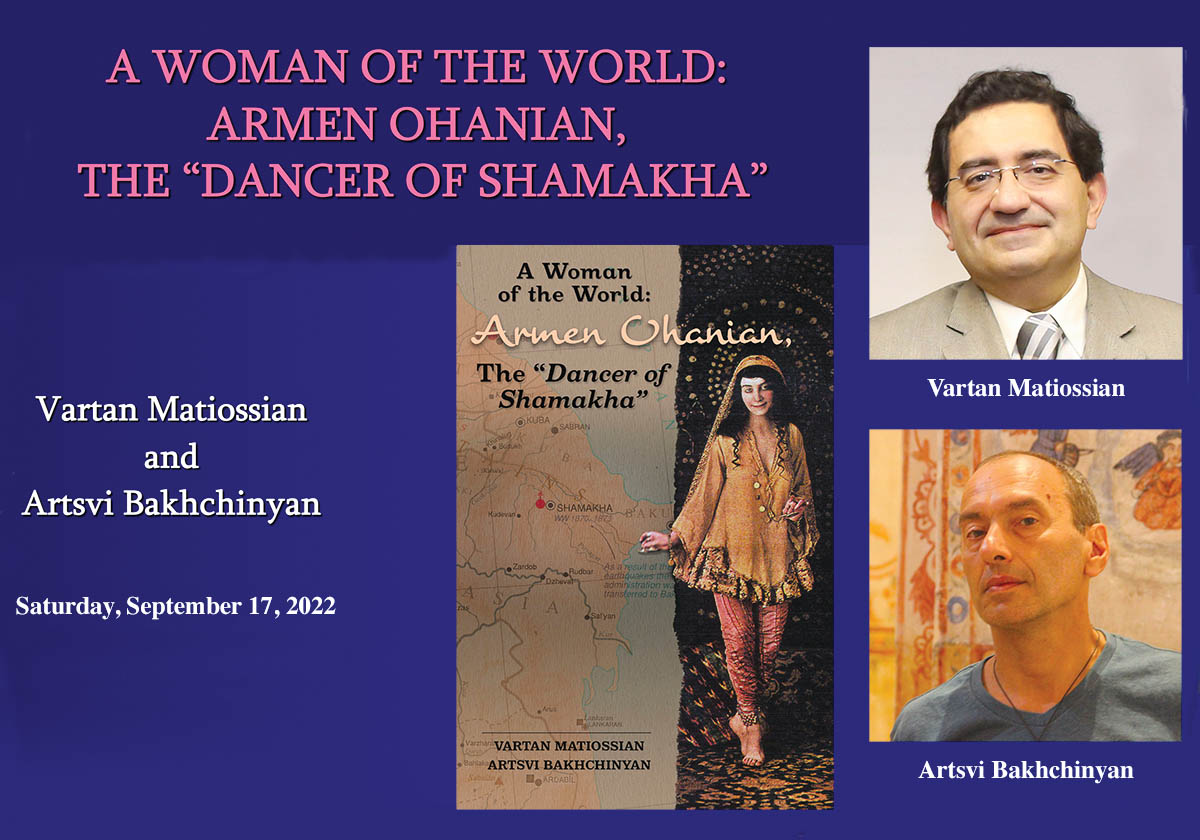 Christine Pambukyan
Christine Pambukyan
Staff Writer
“Armen Ohanian seemed [to be] one of the rare personalities not only in Armenian history but also… in women’s history,” exclaimed Artsvi Bakhchinyan during a lecture describing the life of Ohanian, a “dancer of the Armenian diaspora.”
On Saturday, September 17, 2022, Vartan Matossian and Artsvi Bakhchinyan discussed their new publication in a lecture titled “A Woman of the World: Armen Ohanian, the ‘Dancer of Shamakha’” over Zoom. Dr. Vartan Matossian is a historian and literary scholar of Armenian classical and modern culture. He is currently Executive Director of the Eastern Prelacy of the Armenian Church in New York. Artsvi Bakhchinyan joined the lecture from Yerevan, Armenia. He is a scholar of the Armenian diaspora and culture and a researcher at the Institute of History at the National Academy of Sciences in Armenia.
A Woman of the World: Armen Ohanian, The “Dancer of Shamakha” is the sixteenth volume published by the Armenian Series at Fresno State. The authors of the book provided insight on Armen Ohanian’s life and explained how they conducted research to authenticate their timeline as they presented the life and legacy of Armen Ohanian.
The lecture began by describing the contents of the book and how the publication came to be. “At first, we thought that we would write an article. A twenty-paged article in Armenian, that would do the trick. But then when we started writing, sources started piling up to the point that the article became a book,” explained Matossian as he described the writing of their previous Armenian publication of Ohanian’s biography. This first Armenian version of the book is now translated into English, French, Russian, Spanish, and Farsi.
The new publication is in English and is two times the size of the author’s original Armenian book. “Writing this book was a big, big adventure,” stated Bakhchinyan, “Likewise, Armen Ohanian’s own life was kind of a big adventure through the centuries, through the epochs that she lived.”
Armen Ohanian, born Sofia Emanouely Pirbudaghian, was born in Shamakha in 1888, a historical Armenian province that is currently located in Azerbaijan, and passed away in Mexico in 1976. She was an actress in the Caucasus, a theater director in Paris, a writer in France, a political activist in Mexico, and a dancer from Asia to Africa, and from Europe to America.
“Shamakha, at times, was considered part of Armenia. Not even a part of the Caucasus or part of Iran, but specifically mentioned by non-Armenian sources as far as the fourteenth century as part of Armenia,” emphasized Matossian. Shamakha was known for its dancers, orchards, and earthquakes.
Ohanian was an eyewitness to many political and cultural events. “She was a witness to the Armenian Massacres in Baku in 1905, then she was in Iran during the Constitutional Revolution. She then visited the United States in the roaring twenties, and then worked in the Soviet Union during the first few years after the revolution… Then she was in Mexico… a few years after the Mexican revolution,” described Matossian.
“In 1870, a French Author [Arthur de Gobneau] has written a book called La danseuse de Shamakha which later became one of the first books about Armen Ohanian” mentioned Bakhchinyan when explaining how Armen Ohanian was well-known throughout the world. In 1902, an earthquake in Shamakha caused her and her family to move as the city was destroyed. This caused her family to immigrate to Baku. Her father was a pastor, an educator, and later an oilman. “Sofia’s family was against her being an actress, but she was sure about her career and said that she will marry someone and if they were also against acting, she would divorce them,” stated Bakhchinyan. In 1905, when she graduated from school in Baku, Armen married a medical student named Haik Ter-Ohanian.
When her family was involved in the Baku Massacre in 1905, they fled to Iran, where the couple separated a few years later. Their daughter, Nara, was born in 1906, and later immigrated with Armen to Mexico in 1936.
“According to her contem-poraries, she was not as interesting as an actress, especially her voice was not so relevant for the stage… but because of her movements. She became probably the first Armenian female dancer who received a professional choreographic education,” stated Bakhchinyan. Appearing in Per-sia, she learned dances and gave recitals.
Finally, the authors summarized Ohanian’s contri-butions as an author. As part of “Homage A L’armenie” written in 1916, Armen contributed a poem that she recited for the first time while she participated in a movement as a speaker in Paris, starting her writing career. Ohanian wrote fluently in four different languages. When she moved to Mexico, she became a Mexican writer, and wrote books in Spanish about Mexican, Russian, and Soviet literature and art.
At the end of the discussion, viewers were able to ask Matoss-ian and Bakhchinyan questions through the question module on Zoom. A recording of this discussion can be found on the Armenian Studies YouTube channel at https://www.youtube.com/watch?v=2uWTPkV-AG0. Also, the publication, A Woman of the World: Armenian Ohanian, The “Dancer of Shamakha,” can be purchased online from the Abril bookstore at http://www.abrilbooks.com/woman-of-the-world-a.html, at the Armenian Prelacy website at https://armenianprelacy.org/product/a-woman-of-the-world-armen-ohanian-the-dancer-of-shamakha-softcover/, and the NAASR bookstore at https://naasr.org/products/a-woman-of-the-world-armen-ohanian-the-dancer-of-shamakha.
 Hye Sharzhoom Armenian Action
Hye Sharzhoom Armenian Action